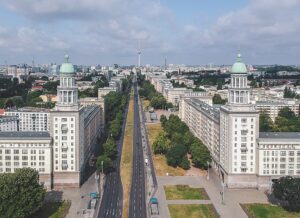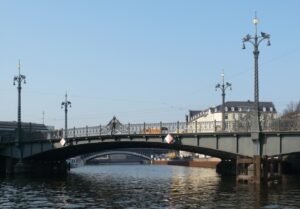As the summer of 2024 looms before us, Berlin once again takes center stage as the «city of politics.» Many people come to visit the German capital to see sites associated with political movements which shaped the so-called Age of Extremes, as the 20th century has sometimes been called. But the elections of 2024, both German and at the EU level, remind us that the past is not even the past in Berlin, as ideologies and attitudes we once thought consigned to Trotsky’s «dustbin of history» are once again rearing their heads and reminding us that Berlin’s stories are always necessary.
Understanding the Purpose of Berlin’s Stumbling Stones
We can see this stark reminder by strolling through the city and looking downwards at the various «Tripping Stones» placed in front of blocks of flats or offices. A local initiative, these brass plaques are about 10 centimeters square, and are set into the sidewalk or pavement in front of buildings where victims of Nazi brutality last voluntarily lived. Each one has the name of a person, with their birth and death dates if known, and their fate. Usually this means murdered in some camp or other.

The Tripping Stones serve two main purposes. First, they are meant to «trip» us out of our thoughts and facilitate the casting back of our minds to the years of the fascist terror. We’re constantly reminded of our modern responsibility, by means of the memory of innocent lives lost, to never allow extremism back into places of power.
Remembering the Individuals Behind the Stumbling Stones
Secondly, these plaques invite us to remember that big historical events like «the Holocaust» or the «Second World War» actually happened to individual people, people with names and birthdates and personalities. The history books with their grand academic themes are rendered flesh and blood.
Most visitors to Berlin appreciate these plaques and the intention behind them, and rightly so. However, current political and global events risk overshadowing their significance, raising an important question: «What is the purpose of remembering?» Or, put another way, «What is (official) memory actually for?»
The Stumbling Stones and Germany’s Modern Challenges
By 2024, two conflicts are disturbing European peace and stability like few other events have done since 1945. The first one is the Russian invasion of Ukraine. One hot topic, featuring in this year’s elections, is the extent to which the EU and, in Berlin’s case, Germany, ought to be supplying arms and supplies to the Ukrainians. Support for Ukraine is far from unanimous, and the issue threatens to send some voters to extreme viewpoints. As one woman I heard in 2022 say in a radio talk show, «I can’t believe it’s 2022 and we’re hearing about the possibility of German tanks in Ukraine. Haven’t we learned anything? We promised ourselves «never again» to war.» War was back, and in the minds of many, Germany’s historic responsibility is to avoid armed conflict no matter what the cost.
Stumbling Stones as a Reflection of Germany’s Memory Culture
Yet to my mind, and to the minds of increasing numbers of people, the lessons of Germany’s turbulent past are not the forswearing of war as such, but rather the prevention of unjust war. If Country A invades Country B based on false or misleading claims and carries out a brutal war of aggression, surely the morally correct thing to do is intervene and stop the massacre. The lesson cannot be that staying out and allowing injustice and murder to take place on our doorstep is fine.
The elections of 2024 are also turning in part on the views one holds about the Israeli mass murder of Palestinian civilians in the wake of the brutal attacks launched by Hamas the previous October. This is not the place to get into the intricacies of that conflict, but the nature of the Israeli response is such that increasing numbers of German voters are becoming uncomfortable with their nation supporting the Israeli government’s response with word, weapons and funding. They are also, in ever increasing numbers, becoming outraged at their inability to express views that fall short of full-throated support for Israel without the risk of being cancelled or hassled by the police, or worse.
The Future of Berlin’s Stumbling Stones: Gesture or Action?
This official support for Israel is based on the memory of the Holocaust and the morally just idea that Germany has a responsibility to be serious about its pledge to never let something like that ever happen again. The brass plaques set into the pavement of the sidewalks underpin this position. Politics always has a consequence for ordinary people, as they elegantly remind us.
This all brings to the fore the question of memory. What are memorials like the Tripping Stones actually doing, in practical effect, a nearly full eighty years after the war? To a remarkable degree, Germany has stood up for Ukraine, but alas with too little, too late. Their fear of getting involved in a war, while understandable and in some ways admirable, is simply prolonging the bloodbath. The German government’s unflinching support of Israel effectively makes it complicit in the Israeli government’s murderous response to the October 2023 outrage.

Memorials are always saying something about us today. They’re there to encourage people to act, or not, in certain approved ways. They’re there to reflect what we think of ourselves and to hold up our ideals to ourselves. They’re there to shape, even subtly, public opinion. On the surface, the Tripping Stones urge us to never let crimes like those of the Nazis from ever happening again. And although history doesn’t repeat itself, the years 2022 to 2024 would suggest that Germany is indeed managing to let «it» happen again by not intervening strongly enough in places where mass killing is taking place. So, we come full circle.
The Stumbling Stones: Berlin’s Living, Breathing Memorials
What does all the official «memory culture» of Germany actually produce in terms of encouraging the German Establishment to do more to prevent massacres and injustice? I would argue that, based on recent events, not enough. My fear is that, as time passes, noble efforts like the Tripping Stones risk becoming mere gesture politics, without any meaningful action following onwards.
It was said in the late 1920s and 1930s that Germany was «dancing on the volcano.» Looking at the Tripping Stones, which commemorate the lives lost when that volcano erupted, remind us that we live today on that same volcanic vent, and it once again is smoking and rumbling. Let’s see what happens this summer. The hope is that the true spirit of «never again» finally seeps through to the ruling classes and they live up to the words and the intentions embodied in their memorials.
Whatever happens, as a visitor to Berlin, look upon the city’s memorials to the bloody 20th century not as mere objects to photograph, but as living, breathing reminders that politics matters, and that your actions, or your silence, matters.
A Call to Action Before It’s Too Late
Berlin is not just a tourist destination; its history serves as a powerful reminder that we have to take action before it’s too late.





